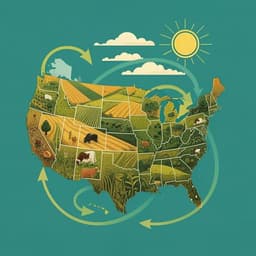
Agriculture
Global crop yields can be lifted by timely adaptation of growing periods to climate change
S. Minoli, J. Jägermeyr, et al.
This innovative research by Sara Minoli, Jonas Jägermeyr, Sennethold Asseng, Anton Urfels, and Christoph Müller explores the adaptation of crop calendars under climate change scenarios. The study reveals that timely adaptation could boost maize, rice, sorghum, soybean, and wheat yields by approximately 12%, highlighting the importance of crop management strategies in mitigating climate impacts.
~3 min • Beginner • English
Introduction
The study addresses how farmers’ adaptive management of growing periods—specifically sowing dates and cultivar choices—can mitigate climate change impacts on global crop yields. Plant phenology is primarily driven by temperature and day length, and warming advances and accelerates phenological development, often shortening growing periods and reducing yields. Yet, annual crop phenology is also shaped by farmers’ decisions, including sowing timing and varietal maturity, which align crops with favorable seasonal windows. Prior global assessments typically used static, observation-based crop calendars, overlooking dynamic adaptation in sowing and cultivar selection. This work aims to quantify how accounting for climate-driven adaptation of crop calendars affects future yields of five major crops globally, identifying expected shifts in sowing and maturity dates and the yield benefits of timely versus delayed adaptation under climate change.
Literature Review
Evidence shows temperature increases advance phenology and can shorten crop cycles, contributing to yield losses. Regional observations indicate farmers already adapt by earlier sowing and selecting later-maturing cultivars (e.g., winter wheat in Germany and China; maize in the USA). Global-scale crop-model assessments have generally assumed static calendars or only adjusted cultivars to maintain historical growing period length, lacking explicit farmer decision rules. Recent rule-based approaches simulate sowing and maturity timing from agro-climatic principles, indicating climate as the primary driver of sowing and cultivar choice and explaining current cropping calendars. However, global implications of adapting these practices under future climates remained unclear, motivating this integrated assessment.
Methodology
- Study scope: Five crops (maize, rice, sorghum, soybean, wheat) under rainfed and irrigated systems on present-day cropland, one crop cycle per year per grid cell, global 0.5°×0.5° resolution, simulations 1986–2099.
- Climate scenarios: Four GCMs (HadGEM2-ES, GFDL-ESM2M, IPSL-CM5A-LR, MIROC5) under RCP6.0 (ISIMIP2b bias-adjusted). Historical forcing uses WFDEI.
- Crop-calendar generation: Combined and improved rule-based algorithms (from prior studies) simulate mean sowing and physiological maturity dates per location using monthly temperature, precipitation, PET, and their seasonality. Rules distinguish temperature- vs precipitation-driven seasonality. Spring crops (maize, rice, sorghum, soybean) sow at onset of wet season or when temperature crosses crop-specific thresholds. Wheat includes three types: winter with vernalization (dormant), winter without vernalization (mild winters, no dormancy), and spring wheat, selected by coldest-month temperature and winter length criteria. Grain-filling timing seeks to avoid heat and terminal water stress; grain-filling duration is set to 60 days (maize) and 40 days (others). Sowing dates do not differ between rainfed and irrigated systems.
- Calibration and evaluation of calendars: Rules driven by observed climate were evaluated against observed gridded crop-calendar datasets at country and grid-cell levels, achieving area-weighted MAE generally below ~30 days for sowing and maturity.
- Cultivar thermal requirements: For each computed sowing–maturity window and location, required thermal units to maturity (TUreq, °C·days) are calculated consistent with LPJmL’s phenology (sum of daily mean air temperature above crop base temperature between sowing and maturity). For winter wheat, effective vernalization requirements (VUreq) depend on cold-month temperatures.
- Crop model: LPJmL5 simulates daily phenology (single phase from emergence to maturity, vernalization included but no photoperiod), photosynthesis (C3/C4), carbon allocation, water balance, and yield. Management other than calendars (irrigation, fertilization, tillage, residue management) follows historical/global datasets. Land-use is fixed to present-day harvested areas.
- Experimental design (counterfactuals for 2080–2099):
1) No adaptation: sowing dates and cultivars fixed at 1986–2005 calendars/TUreq.
2) Timely adaptation: sowing dates and cultivars adapted to 2080–2099 climate.
3) Delayed adaptation: sowing dates and cultivars adapted to 2060–2079 climate, applied in 2080–2099.
Sensitivity cases: sowing-date-only adaptation; cultivar-only adaptation.
- Analysis: Compute 20-year area-weighted mean yields per grid cell and globally; quantify adaptation benefits as yield differences between adapted and non-adapted calendars under the same future climate. Report means and ranges across GCMs. Yield variability assessed via coefficient of variation. In grid cells where adaptation led to no benefit or maladaptation versus no adaptation, losses from adaptation were set to zero, assuming farmers would retain historical calendars.
Key Findings
- Sowing date shifts with adaptation (2080–2099 vs no adaptation):
- Extratropics (temperature-driven): spring crops sow earlier by ~10–30 days; winter wheat with vernalization sows later by ~10–30 days to reduce frost/disease risk; at high latitudes (>50°), some regions switch from spring to winter wheat, effectively delaying sowing by >60 days (from spring to fall). Winter wheat without vernalization tends to show little change or advancement in mild winters.
- Tropics (precipitation-driven): sowing dates change little (±10 days), as onset of rainy season timing shows limited shifts across tested GCMs.
- Maturity and cultivar adaptation:
- Non-adapted warming shortens growing periods; adaptation generally delays maturity to extend the season and avoid peak heat, except in water-limited regions where earlier maturity avoids terminal drought. For wheat, maturity is later where summer temperatures remain <25 °C, and earlier where monthly temperatures exceed 25 °C; high-latitude spring-to-winter transitions also advance maturity relative to non-adapted spring types.
- Adapted cultivars typically require higher TUreq (later-maturing) in extratropics; in tropics, later-maturing cultivars partially offset accelerated phenology.
- Global yield benefits of adaptation (2080–2099, RCP6.0; timely adaptation vs no adaptation; mean across GCMs, range in parentheses):
- All crops combined: +12% (+9% to +15%).
- By crop: maize +17%, rice +17%, sorghum (value not explicitly stated but positive), soybean (positive), wheat +7%.
- Benefits tend to be larger in the warmer GCM (HadGEM2-ES) than the cooler (GFDL-ESM2M).
- Cultivar adaptation contributes more to yield gains than sowing-date shifts alone; combining both yields the largest benefits (except wheat).
- Timeliness matters: timely vs delayed adaptation differences: maize +4%, rice +4%, sorghum +3% at global scale.
- CO₂ and variability context:
- Without adaptation, rising CO₂ tends to offset warming impacts globally, yielding +14% relative to historical on average: C3 crops increase more (rice +24%, soybean +24%, wheat +22%) than C4 (maize −2%, sorghum ~0%). Adaptation responses are similar under elevated and static CO₂, indicating adaptation benefits are largely independent of CO₂ assumptions.
- Yield variability (coefficient of variation): with elevated CO₂, no-adaptation scenarios do not show increased variability above historical; adaptation reduces variability for rice, sorghum, wheat (via higher means), while maize and soybean show higher means and standard deviations but not exceeding historical variability.
- Spatial patterns:
- Largest benefits (>30%) occur in high-latitude temperate regions (e.g., Canada, Russia, Northern Europe), where warming lengthens favorable seasons.
- Substantial benefits (10–30%) in the tropics and key breadbaskets: US Corn Belt (maize, soybean), Southeast Asia (rainfed rice), Sahel (sorghum), North China Plains (irrigated rice).
- Mid-latitudes show smaller overall gains due to limited wheat benefits, potentially reflecting crop-model insensitivity to certain stresses.
- Share of cropland with no yield advantage from adaptation (therefore assumed to retain historical calendars): maize 8% (7–9%), rice 7% (6–8%), sorghum 9% (4–13%), soybean 17% (9–31%), wheat 42% (38–45%).
Discussion
Accounting for farmers’ adaptive management of sowing dates and cultivar maturity substantially alters projected climate impacts on crops, addressing a key omission in prior global assessments that assumed static calendars. The modeled adaptation aligns crops’ critical phases with more favorable thermal and moisture conditions, counteracting phenological shortening and avoiding peak heat or terminal drought. This lifts global yields by about 12% by century’s end relative to no adaptation and enhances benefits where CO₂ fertilization is strong, especially for C3 crops. Findings corroborate regional observations of earlier sowing and adoption of longer-season cultivars under warming. Spatial patterns reveal major opportunities at high latitudes and in many tropical and breadbasket regions. Smaller benefits for wheat in several mid-latitude areas likely reflect missing process representations in LPJmL (e.g., heat, frost, and excess-water stress around sensitive stages), pointing to model development needs. Overall, integrating dynamic growing-season management into global crop projections reduces pessimism about climate impacts and provides more realistic estimates to inform breeding, seed systems, and agronomic planning. Timely adaptation outperforms delayed responses, underscoring the importance of responsive breeding pipelines and access to suitable varieties, particularly in regions with limited market infrastructure.
Conclusion
This study integrates climate-driven decision rules for sowing and cultivar selection with a global biophysical crop model to quantify the effect of adapting growing periods on future yields. It shows that timely adaptation of crop calendars can increase global yields by roughly 12% relative to non-adaptive management under late-century climates, with especially large gains for maize and rice and in high-latitude and many tropical regions. The work demonstrates that adaptation should be routinely included alongside climate and CO₂ scenarios in global assessments (e.g., AgMIP, ISIMIP). Future research should: (i) incorporate intermediate phenological phases (e.g., flowering) and photoperiod responses; (ii) improve representation of extreme-climate stresses (heat, frost, excess water) and potentially canopy temperature; (iii) expand to multi-cropping and rotations; (iv) integrate socioeconomic dimensions (land-use change, technology progress, seed systems and markets) to assess feasibility and uptake of adaptation measures; and (v) refine regional breeding targets to ensure timely availability of later-maturing, locally adapted cultivars.
Limitations
- Phenology in LPJmL is modeled as a single phase without explicit flowering; photoperiod sensitivity is not represented, which may over-sensitize phenology to temperature.
- Limited representation of extreme-climate impacts (e.g., heat stress at flowering, frost damage, soil water excess) may understate or misplace adaptation benefits, particularly for wheat in mid-latitudes.
- Sowing/maturity rules are climate-only; socioeconomic constraints, seed systems, and market access that affect cultivar adoption are not modeled.
- Multi-cropping systems and crop rotations are not represented; only one crop cycle per year per grid cell.
- Land-use is fixed to present-day harvested areas; future land-use change and technological progress are excluded.
- Air temperature is used instead of canopy temperature, potentially biasing phenology under water stress.
- Adaptation considered only via growing periods (sowing date and TUreq); other management adaptations (e.g., irrigation expansion, fertilization changes) are not explored.
- Results depend on RCP6.0 and four GCMs; while ranges are reported, broader scenario uncertainty remains.
Related Publications
Explore these studies to deepen your understanding of the subject.







